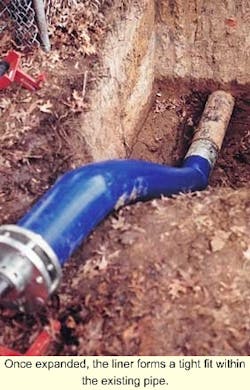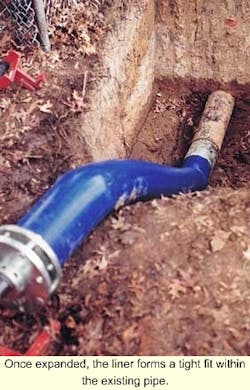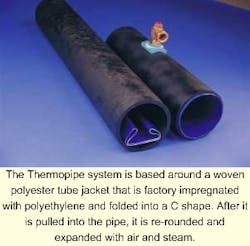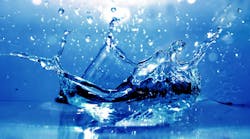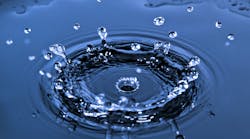The Town of Highland in northwest Indiana receives treated Lake Michigan water from the City of Hammond and stores and re-pumps the water to its own 25,000 residents and the Town of Dyer, IN.
Like many utilities, Highland Public Works keeps records of water main breaks. One eight inch cast iron main, located in the far southeast corner of town, stood out as needing repair or replacement for several reasons, including breaks each year from 1996 through 1998. The breaks were all circumferential, suggesting that settlement was a primary cause.
The main was located two feet horizontally from the curb line and under the concrete pavement of a four lane highway known as Cline Avenue and also as Indiana State Road 912. Ten inch concrete pavement and heavy traffic volume made repairs difficult and presented a risk for Public Works personnel who had to close off a southbound lane to make repairs.
In January 1998, the "daddy" of all water main breaks occurred on this section of main. In the sandy soil adjacent to the pipe, water leaking laterally from the pipe traveled 17 or 18 feet horizontally before coming up at the wall of a residential basement. The pressure bowed the block basement wall and distributed sand over a good portion of the adjacent lawn. The $11,000 repair bill convinced the Highland Water Board it needed to repair or replace the main.
Site Considerations
Cline Avenue is the dividing boundary between Highland and the Town of Griffith to the east. On Highland's side of Cline Avenue, the available right-of-way beyond the curb line extends only five feet. An 18-inch-wide concrete telephone duct and roadway under-drain pipe already were located in this narrow area. Two garages along the 1400-foot route were within nine feet of the curb. There were three lateral connections at side streets, one fire hydrant, three known service laterals and an isolation valve at each end of the 1400 foot section.
Groundwater level was about four to five feet below grade and soils were relatively sandy, which added de-watering costs to open cut alternatives.
Pipe Liner
After evaluating several alternatives, the city decided to repair the main using the Thermopipetrademark lining system from Insituform, in part because using trenchless technology would cause less disruption to the Cline Avenue pavement and traffic flow.
The Thermopipe system is based around a woven polyester tube jacket that is factory impregnated with polyethylene and folded into a C shape. The liner is pulled into the pipe and then re-rounded and expanded with air and steam to form a close fit to the host pipe.
Lining the pipe with Thermopipe appeared to have the lowest overall installation cost. Because the liner does not bond with the inside of the host pipe, it would remain more flexible, providing reduced risk for main breaks due to shear. The liner has a predicted long term burst strength of 328 psi, allowing a continuous pressure rating of 150 psi. It also does not depend on the host pipe for structural support.
Bidding Process
One bidding consideration involved the fact that there were no other products on the market exactly like Thermopipe. Additionally, there were several construction steps that Insituform preferred not to do, such as traffic control, opening access pits, saw cutting concrete, excavation, backfill, trench de-watering and surface restoration.
Project specifications were set up for bidding by general underground contractors. The intent was to have general contractors receive quotes from Insituform to furnish and install the pipe liner, provide cleaning and televising of the line, furnish spare parts and train Public Works personnel to repair the line. Three bids were received from local underground contractors. The possibility that there might be unused service taps to be removed created some degree of uncertainty as to how many access pits would be required. To accommodate the possibility of additional access pits, unit price bid items were established for access pits.
Preparation
Prior to installing the liner several other construction operations needed to take place, such as traffic control. The contractor also had to relocate water service for homes connected to the section to be lined. The town wanted all service connections out from under Cline Avenue, so the crew made permanent taps to side street mains.
The crew also had to dig access pits, which included saw-cutting pavement, excavating and de-watering. Access pits were required at each side street lateral tee connection. The Thermopipe process does not allow installers to come back and cut a hole in the liner at each tee with a robot. Since the liner pipe is not bonded to the host pipe, there is no way to seal the gap between the host pipe and the liner. Each lateral tee was replaced with a new mechanical joint tee. Pits also were required at each end of the project adjacent to shutoff valves, at each active service lateral and at each fire hydrant tee.
The pipe also had to be cleaned and televised before the lining could begin. For the Cline Avenue Project, a high-pressure water blast, flush and pigging were sufficient. Less rigorous cleaning techniques were permissible since there is no chemical bond between the liner and the host pipe.
Televising of the line was done to check the thoroughness of the cleaning process. Camera operators also looked for any protrusion that might cause a puncture in the liner, such as corporation cocks. If a previously abandoned corporation cock protrudes into the pipe more than 1/4 inch, it is best removed. In Highland's case, all corporation cocks had to be removed. Staff also found three abandoned corporation cocks that they didn't know about.
The contractor bid access pit work on a unit price basis per square foot of pavement inside a cut. This worked out well when the crew had to add access pits to remove the abandoned corporation cocks.
Lining Process
In the lining process a twist free rope is passed through the section of main and guide rollers are attached to the cut ends of the main at the planned liner entry and exit points. The rollers prevent damage to the liner from abrasion on the sharp edges of the cut pipe.
The Thermopipe liner is delivered to the site on a reel which can hold up to 740 feet of folded eight inch liner. The reel is positioned over an access pit and the rope attached to the end of the liner with a suitable shackle. The opposite end of the rope is attached to a winch and the liner slowly pulled into the main.
Once the liner is in place, the rope and shackle are removed and one end of the folded liner is softened using steam. This allows the liner to be opened to permit insertion of an injection nozzle. Adjustable clamps are then attached to the opposite end of the folded liner.
The liner is partially opened by injecting clean air or nitrogen gas at a pressure of 7 psi. The air/gas is then gradually replaced by injecting steam which is allowed to vent at the clamps such that a pressure of around 15 psi is maintained. This softens the polyethylene and allows the liner to expand fully into contact with the pipe wall. The liner is cooled by replacing the steam with air/gas.
Once the liner has expanded and cooled, the ends are cut using a gauge so they protrude by a specified length from each end of the main. Special flanged couplings then are fitted over the liner and pipe ends to allow subsequent connection of the lined main, via spool pieces, to other lined or unlined pipe sections, or to flanged fittings such as valves and tees.
On this project the reinstatement of service connections in the lined main was not required. However, when necessary, an adapter can be fitted to the lined main from the outside, using a local excavation, and allowing reinstatement of connections with standard corporation stops. A method also is available for under-pressure installation of new service connections in Thermopipe lined mains.
The process of installing and re-rounding the liner can be completed in less than an hour and in principle the lined main could be back in service within three to six hours. However, current protocols require the main to be flushed and chlorinated and only returned to service once bacteriological testing is complete; a further delay of up to 48 hours.
Summary
Pressure testing the lined pipe at 150 psi went smoothly, as did disinfection with chlorine. The lining process itself is straightforward and took very little time once preparatory work was done. Construction cost for the pipe lining came in somewhat lower than the original estimate, with an average construction cost of $118.60 per linear foot of pipe.
Real success will be measured in how effective the lining system is in preventing future main breaks. So far, Highland has been through most of one winter without a break on the new liner system. The bidding process and construction went reasonably well. The only surprise turned out to be the three extra corporation stops found by the televising crew.
About the Authors: Terry Hodnik, P.E., is one of the founders and owners of NIES Engineering in Hammond, IN. His is a member of AWWA, Public Works Association, ASCE, and received his Masters in Environmental Engineering from the University of Illinois. Dr. John W. Heavens is product manager for Thermopipe at Insituform. He is has a Ph.D. in Fracture Mechanics, University of Bristol, and is a member of the AWWA.
